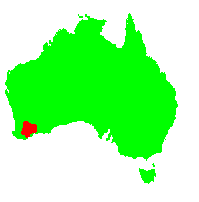General Description:
Banksia is a large genus of over 200 species in the Protea family, having been increased in size through the transfer of species in the former genus Dryandra to Banksia (see footnote box). The genus is almost exclusively Australian, being found in all States and Territories. A single species (B.dentata) is found in islands to Australia’s north as well as in tropical Australia.
As a result of the transfer of the genus Dryandra to Banksia, Dryandra ferruginea was renamed Banksia rufa as the name Banksia ferruginea had been previously applied to a plant taxon, although the name B.ferruginea is not current.
Banksia rufa is a small, variable shrub ranging from completely prostrate to a rounded form 1-1.5 metres in height. Generally the leaves are narrow and long (up to 450 mm) with triangular lobes and having sharp points. The individual small flowers occur in inflorescences on the ends of short branches but they are often held within the plant and may be partly hidden by the foliage. Flower colour may be cream, yellow, orange or brown. The inflorescences are surrounded by brown bracts, giving a Protea-like appearance.
The variability in habit has led to seven subspecies being recognised. The following brief descriptions of the subspecies is based on information in Florabase:
- rufa – Erect to sprawling, bushy, non-lignotuberous shrub, 0.4-0.8 m high. Flowers cream, yellow, brown. Flowering from August to October.
- chelomacarpa – Prostrate shrub, to 0.45 m high. Flowers yellow. Flowering from July to October.
- flavescens – Prostrate, possibly lignotuberous shrub, to 0.45 m high. Flowers cream, yellow. Flowering July/August.
- magna – Very pooly known and no details available.
- obliquiloba – Ascending, lignotuberous shrub, to 1 m high. Flowers yellow. Flowering September/October.
- pumila – Erect, non-lignotuberous shrub, 0.2-0.5 m high. Flowers yellow. Flowering from August to October.
- tutanningensis – Bushy, erect, non-lignotuberous shrub, 0.5-1.5 m high. Flowers yellow, orange. Flowering September/October.
B.rufa has been grown by enthusiasts for some years but is not widely cultivated. It can be expected to be difficult to maintain in humid temperate and tropical areas. Excellent drainage and a sunny location are preferred. It is reported to be slow growing.
Propagation from seed is relatively easy and cuttings may be successful but slow to strike.
A paper published in 2007 proposed that the genus Dryandra be subsumed into Banksia. This revised classification has been accepted by the Council of Heads of Australasian Herbaria and the new Banksia names now appear on Florabase (the website for the Western Australian Herbarium) and in the Australian Plant Census.
The new classification has come in for some criticism but, as the Austraian Plant Census has been adopted as the authority on plant names by ANPSA, the revised classication has been accepted on the ANPSA website. The previous Dryandra names will also be mentioned where appropriate. For further information refer to our Banksia page.

Banksia rufa subsp. pumila (syn. Dryandra ferruginea subsp. pumila)
Photo: Margaret Pieroni
Images of all species in the former genus Dryandra can be seen in the Dryandra Study Group’s Dryandra Image Gallery
 Australian Native Plants Society (Australia)
Australian Native Plants Society (Australia)













